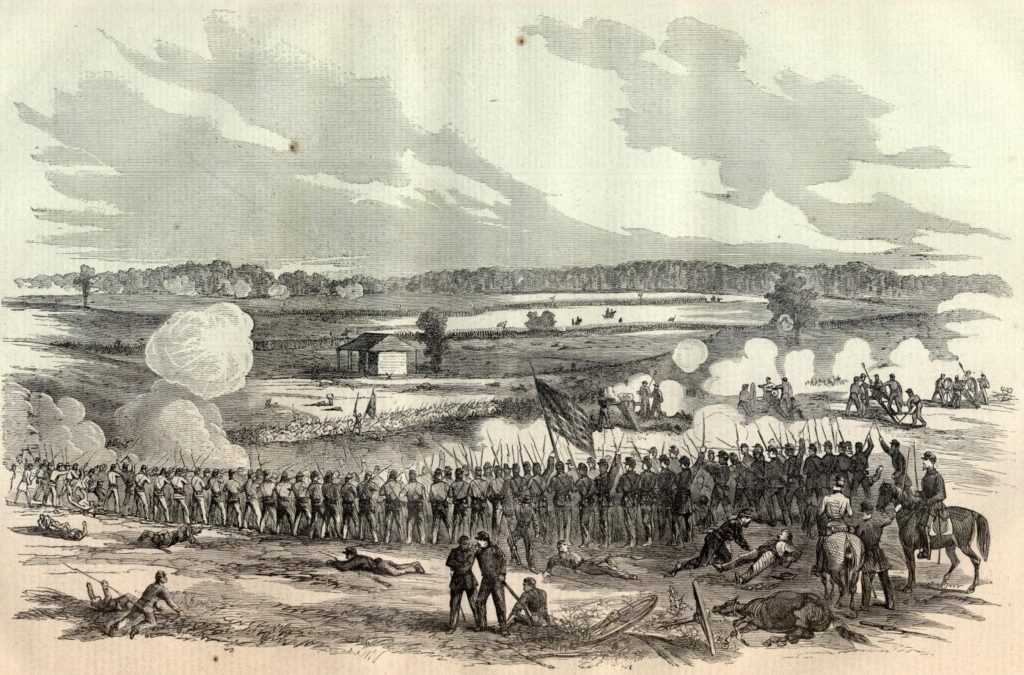Kentucky was the site of 21 different battles during the Civil War, including the Civil War Battle at Middle Creek. On October 8, 1862, Perryville, Kentucky was the site of Kentucky’s bloodiest Civil War Battle in which there were over 7,000 casualties and 1,400 killed.
The Battle of Perryville
The Battle of Perryville was fought on October 8th, 1862 in the Chaplin Hills, just to the west of Perryville, Kentucky. This battle was the culmination of the Confederate Heartland Offensive (also referred to as the Kentucky Campaign), which was a campaign conducted by the Confederate States Army in Tennessee and Kentucky with the goal of bringing Kentucky into the Confederacy ranks.
Commanders of the Battle of Perryville
Union Army
The Union Army was lead by Major General Don Carlos Buell, commander of the Union Army of the Ohio. At his disposal, the Union of Army of the Ohio had 55,000 troops. During the Battle of Perryville, 22,000 of those troops were engaged in battle
Confederate Army
The Confederate Army at the Battle of Perryville was lead by Confederate General Braxton Bragg. He commanded the Army of Mississippi, which consisted of 16,000 troops.
How the Battle of Perryville Played Out
On October 7, Buell’s army, in pursuit of Bragg, converged on the small crossroads town of Perryville in three columns. Union forces first skirmished with Confederate cavalry on the Springfield Pike before the fighting became more general, on Peters Hill, when the Confederate infantry arrived. Both sides were desperate to get access to fresh water. The next day, at dawn, fighting began again around Peters Hill as a Union division advanced up the pike, halting just before the Confederate line. After noon, a Confederate division struck the Union left flank—the I Corps of Maj. Gen. Alexander M. McCook—and forced it to fall back. When more Confederate divisions joined the fray, the Union line made a stubborn stand, counterattacked, but finally fell back with some units routed.
Buell, several miles behind the action, was unaware that a major battle was taking place and did not send any reserves to the front until late in the afternoon. The Union troops on the left flank, reinforced by two brigades, stabilized their line, and the Confederate attack sputtered to a halt. Later, three Confederate regiments assaulted the Union division on the Springfield Pike but were repulsed and fell back into Perryville. Union troops pursued, and skirmishing occurred in the streets until dark. By that time, Union reinforcements were threatening the Confederate left flank. Bragg, short of men and supplies, withdrew during the night, and continued the Confederate retreat by way of Cumberland Gap into East Tennessee.
Considering the casualties relative to the engaged strengths of the armies, the Battle of Perryville was one of the bloodiest battles of the Civil War. It was the largest battle fought in the state of Kentucky.
A Strategic Victory for the Union Army
The Battle of Perryville was not only the bloodiest Civil War Battle in Kentucky, with over 7,000 casualties and more than 1400 deaths, but it was also the largest battle fought in the state of Kentucky. Around 38,000 men fought in the Battle of Perryville on that fateful October day in 1862.
The result of fighting in Perrville that day was one of a Union Army victory. This victory, is sometimes referred to as the “Battle for Kentucky.” Confederate General Bragg withdrew to neighboring Tennessee soon after the battle. This allowed the Union to retain control of Kentucky after the battle. The Union would not cease control of Kentucky for the remainder of the Civil War.
The Battle of Middle Creek was a tragic example of the fratricidal, neighbor-against-neighbor warfare that characterized the struggle for Kentucky. Read about the history of this battle, see reenactments, and the preservation of this site.

